
12 minute read
Albacore: Forerunner to the Future
Albacore Forerunner to the Future Innovative Submarine Shapes the Future of the U.S. Submarine Force
The auxiliary general submarine USS Albacore (AGSS-569) transiting on the surface off the Isles of Shoals, April 1954. Albacore served as a sea-going test platform from 1953 to 1972. Albacore’s teardrop-shaped hull was the prototype for the Navy’s nuclear powered submarine force and was the first boat optimized for submerged performance.
Advertisement
U.S. Navy photo
Wind tunnel tests are performed on a scale model of Albacore’s revolutionary tear-drop shaped hull.
“When in doubt, think speed.”This was the guidance Vice Adm. Charles “Swede” Momsen, Assistant Chief of Naval Operations for Undersea Warfare, gave to designers in 1949 as they began work on the U.S. Navy’s newest submarine. During World War II, the Navy’s Submarine Force proved its combat capability by sinking 30 percent of Japan’s navy, including one of the six aircraft carriers that attacked Pearl Harbor on Dec. 7, 1941. All told, U.S. submarines destroyed over half of the Japanese tonnage lost in the war. During that earlier era submarines were primarily surface vehicles with the ability to submerge, but their outstanding war record inspired Momsen and a series of high-ranking naval officers to put scientists and engineers to work on a true submersible. Speed may have been an initial goal of this design effort, but through successive improvements and the incorporation of new technologies the end result would prove to revolutionize submarine performance and handling, and greatly influence modern submarine design.
The advent of nuclear energy was pivotal to the prospect of designing a true submersible. Since nuclear power plants could operate without the oxygen supply needed by conventional internal-combustion machinery, and because techniques were available for removing carbon dioxide from the ship's atmosphere and creating oxygen for the crew it was possible to envision a submarine that would operate almost exclusively submerged, limited only by the endurance of the crew and supplies. In 1949, the Bureau of Ships authorized the David Taylor Model Basin at what is now the Naval Surface Warfare Center, Carderock Division, to research the ideal architecture of a fast and capable underwater vessel. And thus began the story of a 204-foot submarine that would break the world speed record twice and establish key design parameters for virtually all future submarines – USS Albacore (AGSS-569). From July 1949 to April 1951, the David Taylor Model Basin tested a
U.S. Navy photo
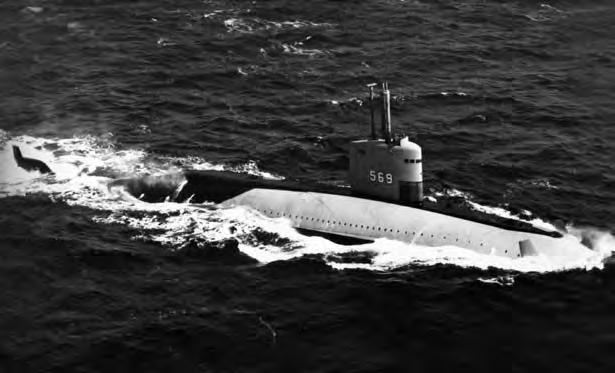
variety of hull forms and associated appendages that would increase underwater speed without jeopardizing surface performance. Designers looked to aviation for inspiration – something aerodynamic would be hydrodynamic as well. Derived from the traditional shape of airships or blimps, a rounded hull in the form of a paraboloid was incorporated in the initial designs. This configuration was then tested in a wind tunnel at Langley Air Force base in two variants – dual and single propeller systems. Because the twin propellers on previous submarines were largely for surface maneuvering and not really required for submerged running, a single, 11-foot diameter, five-bladed propeller was tested. When tests proved that this configuration was the most efficient for propulsion and maneuverability, the single propeller and tear-drop shaped hull were adopted in the initial design of Albacore. HY-80 steel – the toughest and strongest steel yet produced – had just become available and was used for Albacore’s pressure hull. With these innovations, the new design was a milestone in imaginative submarine technology.
For nearly two decades, from 1953 to 1972, Albacore was used as a test platform to validate design features and techniques that made possible the advances in speed, maneuverability, and depth capability enjoyed by today’s Submarine Force. During that period, Albacore went through five design phases and a series of corresponding underwater trials that revolutionized undersea warfare on a step-bystep basis. Built at the Portsmouth Naval Shipyard and commissioned on Dec. 5, 1953 with the Latin motto Praenuntius Futuri, or “Forerunner of the Future,” Albacore would soon demonstrate the aptness of that particular choice.
In Phase I, increasing underwater speed was the primary goal. The ship’s designers made every effort to streamline the hull. The sail was smaller than normal and served only to house the necessary masts. The rudder and diving planes, or control surfaces, were placed behind the single propeller. Because of limited internal volume for both crew and equipment, the engineers adopted one-man aircraft-style controls that integrated the operation of planes and rudders. The single helmsman controlled depth by pushing the wheel fore and aft for down and up angles and turning it like a steering wheel for direction. Electronics Technician Jim Tyrell remembers being at the wheel. “I actually learned to control Albacore in that way. A few years after I got out of the Navy, I took flying lessons. The instructor was amazed I could fly a plane the first time I tried. It felt exactly like flying Albacore”.
As the ship-control team became more confident, Albacore was subjected to increasingly tight turns at high speed and surprised her crew with near “snap rolls” that caused extreme heeling. To minimize this dangerous effect, a dorsal rudder was attached to the rear of the sail. However, the rudder caused too much control sensitivity, turning Albacore at the slightest touch of the wheel. Small aircraft-type trim tabs were installed to minimize the use of the larger control surfaces and ensuing trials showed that the sail-mounted rudder was not
(left) Albacore, seen here in Oct. 1961, with it’s innovative “X” tail.
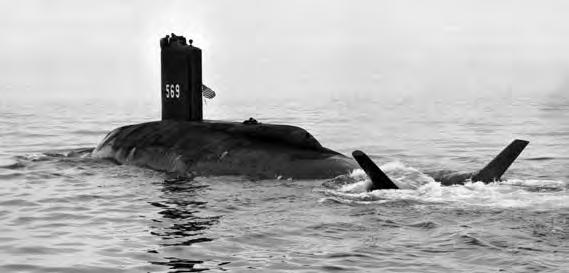
(right) Albacore’s dive breaks can be seen in their deployed position.
U.S. Navy photo
necessary for adequate maneuverability. It was dropped in the next design phase but would be reintroduced in Phase III. In Phase I, Albacore had shown that a single-stick control station for the bow planes, stern planes, and rudder allowed piloting to be a one-man job. Ultimately, however, the U.S. Navy would be one of few to reject this system because it was thought to be unreliable and that human error was too great a possibility. During Phase I, Albacore was also the first to use a single periscope that combined the functions of an attack periscope and a search/ night periscope.
Albacore went through design Phase II from December 1955 to March 1956. During this phase, control surfaces were moved in front of the propeller and arranged to be horizontal and vertical, forming a “+” shape. The dorsal rudder on the sail was deactivated and the small forward planes were removed not only for the reasons given above, but because they created drag and slowed the boat down. The new design provided excellent highspeed maneuverability. In another change, the diameter of the propeller was increased from 11 to 14 feet, which could turn more slowly and was quieter, but it proved relatively less effective and was deleted in the next phase. Other tests evaluated a fiberglass sonar dome carrying the BQS-4 sonar and a towed array fitted to the end of the submarine.
Soon, the technologies which had thus far proven successful on Albacore were applied in new construction. USS Barbel (SS-580), commissioned in 1959, was the first of a three-boat, conventionally-powered class to incorporate the tear-drop hull design and HY-80 steel. At that same time, the Skipjack (SSN-585) program combined the Albacore’s hull shape, single axially-mounted propeller, and HY-80 steel with the nuclear propulsion system that had been pioneered on the USS Nautilus (SSN-571) to create the prototype of the modern attack submarine.
Phase III took place from 1957 to 1961. The designers again experimented with new control surfaces. In this phase, control surfaces were still forward of the propeller but were mounted diagonally, forming an “X”-shaped configuration. This new design was expected to facilitate sharper turns, so a larger dorsal rudder was installed on the sail and re-activated. Ten hinged panels ringing the aft part of the boat were installed on Albacore as speed brakes. These panels were hydraulically operated to slow the boat rapidly if necessary. In addition, a drag parachute from a B-47 bomber was installed on the aft edge of the sail, which could be opened and streamed in an emergency to slow the boat and decrease the down angle. As clever as this idea may have seemed, the parachute ripped out after three test runs and was deleted from future designs.
The “X” stern configuration and dive brakes were potential solutions to a recurring concern about uncontrollable crashdives. Because the individual control surfaces in the X configuration needed to operate with coordinated motions to affect a dive, no single mechanical failure could cause a crash dive. Because these potentially-dangerous inadvertent dives were less likely, Albacore could attempt more dangerous maneuvers at little risk. Nonetheless, neither of these features would be included in the next design. The dive brakes occasionally opened on their own at high speeds, and the X-stern required computer control at a time when computers were little understood and yet to be trusted.
In 1962, Albacore went into Phase IV. During this period, the single propeller was replaced by a 10-foot diameter, 7- bladed forward propeller, in tandem with an 8-foot diameter, 6-bladed aft propeller. The spacing between these two propellers was set at 10 feet and a second 7,500-SHP motor was added to drive the second screw. The separation distance was later decreased to five feet which proved optimal for propulsion efficiency. In February 1966, when most submarines were averaging speeds of 10 knots submerged, the Albacore was credited with the world record of 33 knots underwater. In an attempt to reach similar speeds in an operational boat, USS Jack (SSN-605), commissioned in 1967, incorporated counter-rotating propellers in its
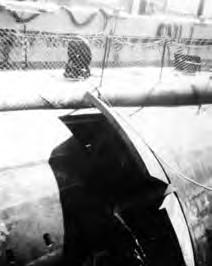
design. But Jack was never able to reach Albacore’s speed, and the counter-rotating propeller system would not be used in any future submarine classes.
The Submarine Force suffered a major catastrophe while Albacore was working through Phase IV. In 1963, during deepdiving trials, USS Thresher (SSN-593) suffered a flooding casualty and was unable to blow her ballast tanks and surface, resulting in the loss of the submarine and all aboard. In response to this tragedy, an emergency blow system was installed and tested on Albacore. This new system ran a maze of piping from the air banks, through the control room and then to the ballast tanks. In the control room, the blow valves could be operated manually to expel ballast in each tank. When there was an emergency, a flip of the “chicken switch” blew all the ballast tanks and the submarine would rise rapidly to the surface. Quartermaster Norm Bower recalls this experience,
“After testing the system on the surface, we went to sea to test it while submerged. Our first test was from a depth of 100 feet and a dead stop. The blow was initiated and the boat rose rapidly to the surface. The second test was… from 300 feet… When the blow began, the boat immediately took a huge [54 degree] angle to starboard and stayed that way
Albacore Innovations Throughout the Years
July 1949:
David Taylor Model Basin tests hull designs
Nov. 24, 1950:
USS Albacore (AGSS-569) ordered
March 15, 1952: Keel laid
Aug. 1, 1953: Launched with teardrop shaped hull and a dorsal rudder attached to the trailing edge of the sail
Dec. 5, 1953: Commissioned
1953-1955:
Phase I: Control surfaces aft of single propeller
1956:
Phase II: Propeller moved aft of cruciform control surfaces, dorsal rudder deactivated, and forward planes removed.
1957-1961: Phase III: X-shaped control surfaces, 10 diving breaks around hull, a new bow, new sonar system, larger dorsal rudder installed and activated
1962-1965:
Phase IV: Installed contra-rotating propellers, larger battery, and larger main motor
Feb. 1966:
Set world record for underwater speed at 33 knots
Jan. – April 1968: Returned to Portsmouth, N.H. for modification of propulsion system.
Aug. 1969 – Aug 1971:
Phase V: 'Slippery Water' project
Sept. 1, 1972: Decommissioned and placed in the Inactive Ship Facility in Philadelphia
1984:
Towed to Portsmouth, N.H. to be restored as a museum
Aug. 30, 1986:
Maritime Museum at Albacore Park opened to public
April 11, 1989:
Designated a National Historic Landmark
2000:
Designated a Historic Mechanical Engineering Landmark and a Historic Welded Structure for her hull
May 2005: Inducted into the Submarine Hall of Fame in Norfolk, Va. for her contributions to submarine engineering and tactics
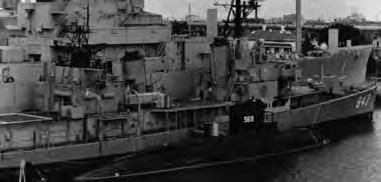
until we reached the surface…we did the blow from 500 feet and we shot to the surface with no problem.”
In Phase V, August 1969 to August 1971, the designers attempted to push Albacore even faster by lowering the friction of the water flowing over the hull in an early drag-reduction technique. Her crew called it the “Slippery Water” project, and it included the release of a viscous polymer liquid that would stream down the hull and reduce drag. Some drag reduction was observed, but so much polymer had to be ejected, and stored on board, that this method was deemed impractical. Since then, many tests have been done to develop a more efficient approach, but to date, no drag reduction schemes of this type have been deployed operationally.
“Slippery Water” was Albacore’s final test. After having been used for successful
U.S. Navy photo
experiments on the tear-drop shaped hull, new diving controls, and high-yield steel for her pressure hull, plus testing sail rudders, speed brakes, drag chutes, counter-rotating propellers, and three different arrangements for her control surfaces, she was ready to retire. In September 1972 Albacore was decommissioned and placed in the Inactive Ship Facility in Philadelphia.
Ten years would pass before a volunteer group, the Portsmouth Submarine Memorial Association (PSMA), would bring Albacore home to Portsmouth, N.H. The submarine was towed 575 miles from Philadelphia to Portsmouth. After another year, she was towed up the Piscatiqua River and then moved a quarter mile inland from the river. This required dismantling 30 feet of a railway trestle, carving out 70 feet of a four-lane highway, and raising the boat 27 feet above the river to finally rest on dry land. On Aug. 30, 1986 the Maritime Museum at Albacore Park opened to the public. Three years later, on April 11, 1989, Albacore was designated a National Historic Landmark, and in 2005, she was inducted into the Submarine Hall of Fame in Norfolk, Va. for her contributions to submarine engineering and tactics.
In retrospect, Albacore’s true legacy is that it was the Navy’s first design effort to stress a submarine’s underwater performance over its surface performance. It was the first attempt to develop a truly submersible combat ship and Albacore’s achievements – and the incorporation of revolutionary new technology – made the effort a success and ultimately set the U.S. Navy on its path towards building today’s modern submarine fleet.
Ms. Scrafford is a communications specialist with General Dynamics Information Technology in Washington, D.C.
Bibliography:
http://www.ussalbacore.org/
Friedman, Norman. U.S. Submarines Since 1945 - An Illustrated Design History, U.S. Naval Institute Press (1995)
The Naval Service Warfare Center, Carderock Division provided the following:
Potentialities of the Albacore-Type Submarine. Talk given by Morton Gertler of the David Taylor Model Basin to The American Society of Mechanical Engineers. Philadelphia, Pa.
Heffner, James A. USS Albacore (AGSS 569) Standardization Trial Results with Contra-Rotating Propulsion System (U). March 1967.
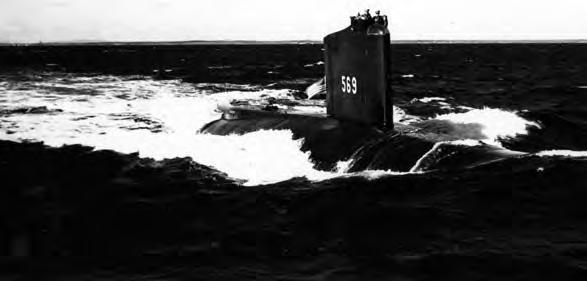
U.S. Navy photo








